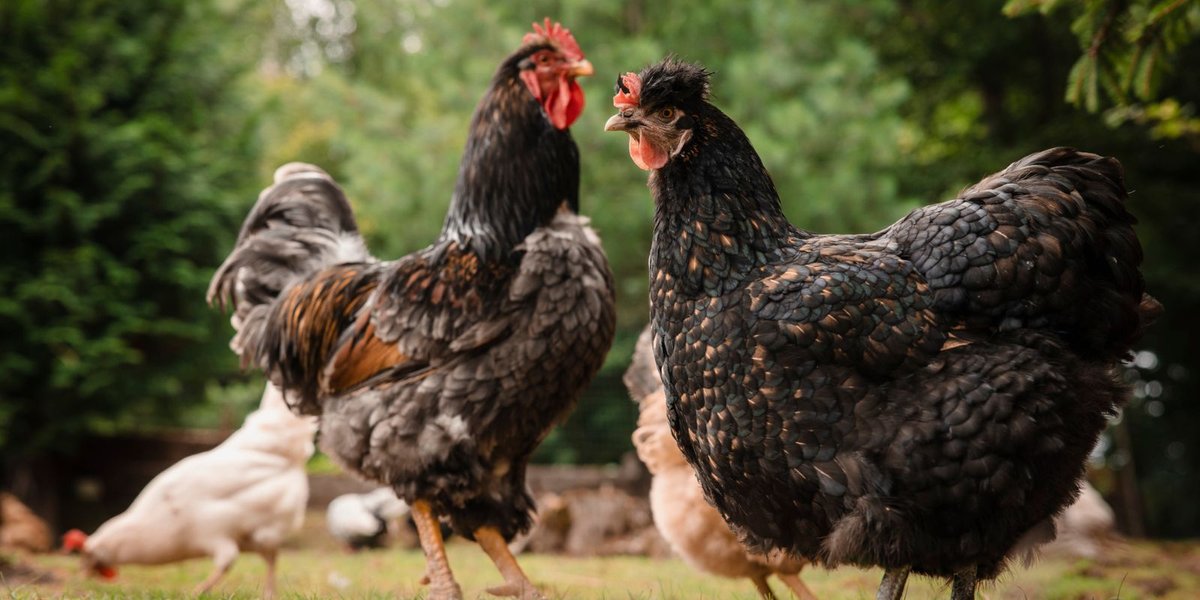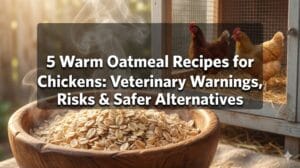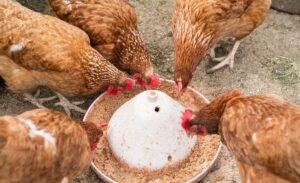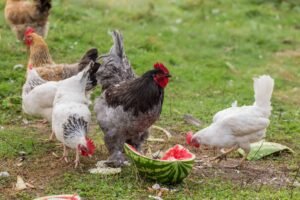There’s nothing quite like the feeling of collecting your first fresh eggs from your own backyard flock. The secret to a consistent supply of delicious eggs, as well as happy, healthy birds, is a well-planned and consistent feeding schedule. As a backyard chicken keeper for over 5 years, the one thing I’ve learned is that a consistent feeding routine is the bedrock of a healthy flock and a key part of good animal husbandry.
In this guide, we’ll break down everything you need to know about feeding your chickens—from what they should be eating and how much to give them, to the best feeding schedules and essential supplements. We’ll answer all your common questions and set you up for success.
The Foundation: Understanding Your Chickens’ Eating Habits
Before we get into schedules, it’s important to understand how a chicken’s body and mind work when it comes to food. This knowledge will help you feel confident in your feeding strategy.
Do Chickens Stop Eating When They Are Full?
Yes, they do! Chickens are excellent at self-regulating their food intake. They will eat what they need to meet their daily energy requirements, and once they are full, they will stop. This natural behavior is the main reason that free-feeding is such a popular and efficient method for backyard chicken keepers. This natural instinct helps prevent obesity and ensures they get the chicken nutrition they need, especially on a balanced commercial feed.
Can Chickens Go Without Food and Water Overnight?
Absolutely. Chickens naturally roost and sleep when it’s dark, and they don’t eat or drink while they’re sleeping. Their digestive system is designed to handle this. Before they go to roost in the evening, they’ll fill their “crop”—a small pouch at the base of their neck—with enough food to begin the initial digestion process overnight. This allows them to go without food until morning.
The Role of the Crop and Gizzard
A chicken’s crop is a temporary storage sac. When a chicken eats, the food goes down its esophagus and collects in the crop. It can hold enough food to sustain them for a few hours. From the crop, the food moves to the gizzard, a muscular organ that grinds the food into a digestible pulp. This is where grit becomes so important, as it provides the tiny stones necessary for this grinding process.
Understanding these fundamentals about your flock’s digestive system makes it easier to create a feeding routine that works for both you and your birds. Now, let’s explore the best schedules to put this knowledge into practice.
What Is a Good Feeding Schedule for Chickens? Morning vs. Evening vs. Free-Feeding
The best feeding schedule depends on your lifestyle and your goals for your flock. There are two primary methods to consider, and a popular hybrid option.
Method 1: Free-Feeding (The Most Common & Efficient Method)
What it is: This method involves providing your chickens with constant, 24/7 access to their feed. You simply keep their feeder full so they can eat whenever they want throughout the day. This is a very popular free-feeding chickens method.
- Pros: It’s the simplest method and ensures your chickens always have food. It also reduces stress and pecking order issues, as a nervous chicken won’t have to compete for a limited food supply. Chickens can top up their crops at their leisure, which is especially useful for high-producing hens.
- Cons: An open feeder can attract pests like mice and rats. Also, feed can get wasted if the feeder is not well-designed or if the birds knock it over. Feed can also spoil or get moldy if exposed to moisture.
- Recommendation: For most backyard keepers, a well-designed, treadle-style or hanging feeder is the best solution for free-feeding. It keeps the food clean and dry while minimizing access for pests.
Method 2: Scheduled Feedings (Morning & Evening)
What it is: This method involves providing food at set times each day, typically in the morning and evening, and then removing any uneaten food. This approach of scheduled feeding can be effective for managing waste.
- Morning Feeding: This is a great way to encourage your chickens to leave the coop and start their day of foraging and laying. A good breakfast gives them the energy they need.
- Evening Feeding: Offering a meal in the evening ensures your chickens go to roost with a full crop, which is especially beneficial in cold climates to help them stay warm overnight.
While this method can help control pests and prevent wasted food, it’s more labor-intensive and can cause stress if the birds feel they need to compete for food. It is most useful for keepers who need to carefully monitor a chicken’s intake, such as with overweight birds or those on a specific dietary plan.
Method 3: The Hybrid Approach
Many keepers combine free-feeding with scheduled treats. This means you provide free-choice access to their main feed at all times, but you offer healthy scraps, scratch grains, or high-protein treats at a specific time each day. This gives you the convenience of free-feeding while also providing a fun, interactive routine for your flock.
Choosing the right schedule is the first step toward a healthy flock. Once you have a schedule in mind, you can build your daily routine around it, ensuring all your birds’ needs are met.
Your Daily Routine for Backyard Chickens
A daily routine is about more than just feeding; it’s about overall care. Here’s a simple checklist to guide you:
- Morning (7 AM): Open the coop door and let your chickens out. As they emerge, check on their general health—look for any limping, sneezing, or lethargy. Provide them with fresh, clean water, and top up their feeder with their complete feed.
- Mid-day (Optional): This is a great time to offer a few healthy treats or garden scraps. This is also a good time to check on water levels, especially on hot days.
- Afternoon (4 PM): Check the nesting boxes for eggs and collect any you find. A good layer will usually lay her egg by the afternoon.
- Evening (Dusk): Wait until all your chickens have gone into the coop to roost, then securely close the door to protect them from predators. Do a quick check on their food and water levels to make sure everything is okay.
A consistent daily routine is the hallmark of a well-cared-for flock. Knowing how much food to provide is the next piece of the puzzle to ensure your chickens are always satisfied.
How Much Food Should a Chicken Eat Per Day? (Cups, Lbs, and KGs)
Knowing the general quantity of feed per chicken will help you manage your food supply and budget.
The General Rule of Thumb
An average adult, standard-sized laying hen eats about 1/4 pound (113g) or roughly 1/2 cup of feed per day. This amount can vary slightly depending on the breed, the size of the chicken, their age, the weather (they eat more in winter to stay warm), and if they are free-ranging or foraging (they may eat less commercial feed as they supplement their diet with bugs and weeds). This answers the question of how many cups of feed per chicken is needed.
Feed Calculation Table
Here’s a simple table to help you estimate how long a standard 50lb bag of feed will last (think of this as a quick chicken feed calculator).
| Number of Chickens | Daily Feed (approx.) | 50lb (22.7kg) Bag Lasts |
|---|---|---|
| 5 | 1.25 lbs / 2.5 cups | ~40 days |
| 10 | 2.5 lbs / 5 cups | ~20 days |
| 20 | 5 lbs / 10 cups | ~10 days |
| 100 | 25 lbs / 11.3 kg | ~2 days |
Now that you have a solid understanding of quantity, let’s explore the types of food that make up a healthy, balanced diet for your birds.
What Should You Feed Your Chickens Daily? A Guide to Feed, Treats, and Supplements
The 90/10 Rule for Feeding Chickens Explained
This is a critical concept for every chicken keeper. The 90/10 rule states that 90% of a chicken’s diet should be a complete, commercially formulated feed. The other 10% can be made up of treats, kitchen scraps, and scratch grains. Sticking to this rule is vital to prevent nutrient deficiencies, which can lead to health problems and a drop in egg production. While some people are interested in homemade chicken feed or natural chicken feed, it’s very difficult to meet a chicken’s full nutritional needs without a balanced commercial feed.
Choosing the Right Complete Feed
The best type of feed depends on your flock’s age and purpose. The physical form of the feed also matters. For a detailed breakdown of different feed types and their nutritional value, you can consult a reputable source like this poultry nutrition guide from Nutrena.
- Pellets, Crumbles, and Mash:
- Pellets are the most common and are great for reducing waste, as the chickens can’t sift through them.
- Crumbles are pellets broken down into smaller pieces, which are easier for smaller breeds or younger chickens to eat.
- Mash is a finely ground meal that can be fed dry or wet. It’s often used for very young chicks and can be mixed with water to make a paste.
- For Laying Hens: The best chicken feed for laying eggs is a Layer Feed. This feed is specifically formulated with about 16% protein and, most importantly, extra calcium, which is essential for strong eggshells and to increase egg production.
- For Fast Growth: If you’re raising young chicks or meat birds (broilers), you’ll want to use Starter Feed (for chicks up to 6 weeks) and then Grower Feed (for birds up to laying age). These feeds have a higher protein content (18-22%) to support rapid development and provide food for fast growth.
Healthy Treats That Increase Egg Production
While a complete feed is the foundation, certain healthy treats can help increase egg production and provide extra protein and vitamins. Here’s a list of what vegetables can chickens eat and other safe treats:
- High-Protein Treats: Mealworms and black soldier fly larvae are excellent for a protein boost, especially during molting or in winter. You can also offer a small amount of sunflower seeds or cooked meat scraps.
- Calcium-Rich Greens: Chickens love leafy greens like kale, spinach, and collard greens, which provide calcium and other vitamins. Fermented grains can also be a healthy treat that aids in digestion.
Safe vs. Dangerous Foods: What Not to Feed
While chickens can eat many things, some foods are toxic or can cause health problems. Always stick to this list to be safe.
✅ Safe Treats in Moderation:
- Vegetables: Leafy greens (kale, spinach), squash, cooked beans (never raw), carrots, broccoli.
- Grains & Carbs: Oats, cooked rice, pasta.
- Fruits: Berries, melon, apples (no seeds).
❌ Dangerous & Toxic Foods (Never Feed):
- Avocado (all parts)
- Raw or green potatoes
- Dried or uncooked beans
- Onions and garlic in large amounts
- Citrus fruits
- Chocolate or sugary sweets
- Moldy or spoiled food
Essential Supplements: Grit and Oyster Shell
A common mistake for beginners is to forget these two crucial supplements.
- Grit: Chickens don’t have teeth! They use insoluble grit, which is a mix of small rocks and sand, to grind down food in their gizzard. This is essential for proper digestion, especially if they are not free-ranging. According to poultry experts at The Cooperative Extension at Penn State University, grit can improve a chicken’s feed efficiency and overall health.
- Oyster Shell: Even with a high-calcium Layer Feed, some hens need more calcium for strong eggshells, especially prolific layers. Offer soluble grit like crushed oyster shell in a separate container so your chickens can take it as needed.
Understanding the what to feed your flock is just one part of the equation. It’s also vital to know how their needs change as they grow.
How Should I Feed My Chickens as They Grow?
The nutritional needs of a baby chick are completely different from a laying hen. Following a proper feeding schedule through their early life is crucial for a healthy, productive adult flock.
The First 6 Weeks: Starter Feed
Immediately after hatching, chicks should be put on a specialized Starter Feed. This feed is usually a non-medicated crumble with a high protein content (20-22%) to support their rapid early growth. You should provide this feed free-choice in a chick-specific feeder.
Weeks 6 to 18: Grower Feed
Around 6 weeks of age, your chickens are no longer considered chicks; they are now pullets. At this point, you should transition them to a Grower Feed. The protein content is slightly lower (18-20%), which helps them continue to grow without putting on too much weight. Continue to provide this feed free-choice.
The Final Transition: To Layer Feed
When your pullets reach about 18 weeks of age or just before their first egg, it’s time to switch them to a Layer Feed. It’s important to make this transition slowly over a week to prevent digestive upset. This feed, with its higher calcium and lower protein, is designed to support egg production.
A chicken’s diet changes as they age, but there are also other factors to consider. The weather, for instance, has a major impact on their nutritional needs.
How Does the Season Affect My Chickens’ Feeding Needs?
A chicken’s metabolism and nutritional needs fluctuate throughout the year. Adjusting their diet seasonally can help them stay healthy and productive.
Winter: More Energy, More Fat
In colder months, chickens need more energy to stay warm. You can help by increasing the number of scratch grains you offer. A handful of corn or other grains in the evening gives them extra carbohydrates to burn overnight, acting like a natural internal heater. You can also offer warm, cooked treats like oatmeal to encourage them to eat.
Summer: Hydration and Heat
During hot summer months, a chicken’s appetite can decrease. Their primary need is hydration. Ensure they have constant access to cool, fresh water. You can also give them frozen treats, like frozen vegetables or a block of frozen water with treats inside, to help them cool down. Avoid heavy, high-carb foods like scratch grains during the day, as digesting them generates body heat.
Adjusting their diet for the weather is a simple way to care for your birds. But even with the right food, a feeding schedule is only as good as the water you provide.
Why is Water So Important for My Chickens?
While we often focus on feed, fresh water is the single most important part of a chicken’s diet. A hen can survive a day without food, but without water, her health and egg production will suffer rapidly.
The Critical Need for Water
Egg production is a water-intensive process. An egg is made up of about 75% water, and a drop in water consumption for even a few hours can cause a hen to stop laying. Dehydration is a serious health risk, especially in the summer.
How to Provide Clean Water
Always provide clean, fresh water that is free from contaminants. Check the waterer daily and clean it at least once a week to prevent the buildup of bacteria. In the winter, you must prevent the water from freezing. Heated waterers or swapping out water several times a day are essential solutions.
With a proper diet and constant access to water, your flock should thrive. However, every chicken keeper eventually runs into common feeding problems, so knowing how to solve them is essential.
How Can I Solve Common Chicken Feeding Problems?
Even with the best intentions, you may encounter issues with your chickens’ feeding habits. Here are a few common problems and their solutions.
Feed Wasted or Eaten by Pests
If you’re finding feed scattered on the ground or notice mice and rats, your feeder may be the issue. Switch to a treadle feeder that only opens when a chicken stands on it, or a hanging feeder that they can’t scratch out. Store your feed in a sealed metal container to keep pests out. This is a critical component of flock biosecurity, which helps prevent the spread of disease.
When a Hen Goes Broody
Broodiness is the instinctual behavior of a hen to sit on eggs to hatch them. A broody hen will often stop eating and drinking, focusing solely on the eggs. It’s important to check on her daily and gently encourage her off the nest to eat and drink. A broody hen’s health can decline rapidly if she doesn’t get enough nutrition.
Sour Crop and Impacted Crop
Sour crop is a fungal infection that causes a chicken’s crop to swell and have a foul smell. It’s often caused by a diet that is too high in treats or by food that has become impacted and won’t move to the gizzard. Avoid overfeeding treats and ensure your flock has access to grit to aid digestion.
Knowing how to troubleshoot these issues will give you more confidence as a chicken keeper. Now, let’s wrap up with a final summary of all the key takeaways.
Frequently Asked Questions (FAQ)
What is the most efficient way to feed chickens?
The most efficient method is using a high-quality, no-waste hanging or treadle feeder filled with a complete feed that they can access freely. This reduces spillage and prevents pests.
What food makes chicken grow faster at home?
A high-protein (20-22%) “Broiler” or “Grower” feed is formulated to support rapid growth in developing chicks and meat birds.
How much does it cost to feed 100 chickens per day?
A quick calculation: 100 chickens will eat about 25 lbs of feed per day. If a 50lb bag of feed costs around $25, your daily cost would be approximately $12.50.
How much to feed chickens per day in kg?
An average adult laying hen eats about 113 grams of feed per day, which is roughly 0.113 kilograms.
What should I feed baby chicks?
Baby chicks require a higher protein diet. You should feed them a specialized Starter Feed (usually 20-22% protein) for their first 6-8 weeks of life.
What should I feed chickens during molting?
Molting chickens need extra protein to regrow their feathers. During this time, you can supplement their diet with high-protein treats like mealworms, black soldier fly larvae, or even a specialized “molting feed” that has a slightly higher protein content.
Conclusion: Your Key to a Happy, Healthy Flock
Ultimately, the best feeding schedule for your backyard chickens is one that is consistent, provides a balanced diet, and works for you. By focusing on the 90/10 rule, providing a high-quality layer feed, ensuring constant access to fresh water, and supplementing with grit and oyster shell, you are setting your flock up for a long, healthy, and productive life. A happy chicken lays delicious eggs, and it all starts with what’s in their feeder.

Oladepo Babatunde is the founder of ChickenStarter.com. He is a backyard chicken keeper and educator who specializes in helping beginners raise healthy flocks, particularly in warm climates. His expertise comes from years of hands-on experience building coops, treating common chicken ailments, and solving flock management issues. His own happy hens are a testament to his methods, laying 25-30 eggs weekly.



